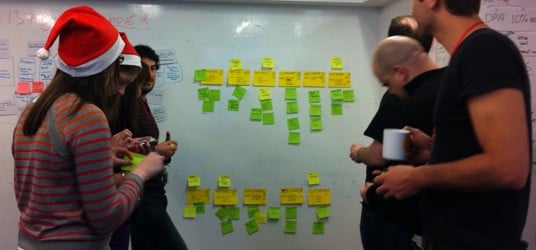We gathered Product Managers, Delivery Managers, the Head of Design and the Head of User Testing around this wall every two weeks to manage our portfolio of projects and products. The process forced us to flag dependencies, show blockers and compromises.
Lesson: This approach was successful up to a point but in hindsight I wish we had adopted a Kanban system across the programme from the outset. It would have provided additional mechanisms for tracking dependencies, limited work in progress and increase focus on throughput. I would also formalise a Portfolio Management team to help manage this.
Everything you’ve learnt as a project or programme manager is still useful
When I started using agile, someone said me, “when things get tough and you want to go back to old ways, go more agile, not less”. This has stuck in my mind.
When I was designing the shape of the programme and working out how we would run things I wanted to embed agile culture and techniques at its heart. For example, we used a plain English week note format to share what happened, what was blocking us sprint to sprint rather than a traditional Word or Excel status report.
In tech we always say we’ll use the right tool for the job and in programme management the same is true. In the same vein I opted to use a gantt chart as a way of translating milestones and timings to stakeholders but internally we never referred to it and were not slaves to it.
Risk and issue management is an important aspect of any programme. The usual agile approach of managing risks on walls scaled less well into the programme. Typically in smaller teams you might write risks, issues and blockers on a wall and have collective responsibility for managing them. We scaled this approach to our stand up of stand ups and this worked well for the participants: it was visible, part of our day to day process, we could point at them and plan around mitigation.
But there was a moment when the management team asked for a list of risks and issues and pointing them at a wall was not the best answer so we set up a weekly risks and issues meeting (aka the RAIDs shelter) and recorded them digitally. This forum discussed which risks, issues, assumptions and dependencies were escalated. By the book it fits least well with the agile meeting rhythm but it gave us a focal point to discuss concerns, plan mitigation and fostered a blitz spirit.
We have some way to go to make it perfect but we have learned that within GDS agile can work at scale. We’ve embraced it culturally and organisationally and we’ve learnt an awful lot on the journey. Some of the lessons we've learnt have already been incorporated into how we’re working now and I look forward to sharing more about this in the future.













